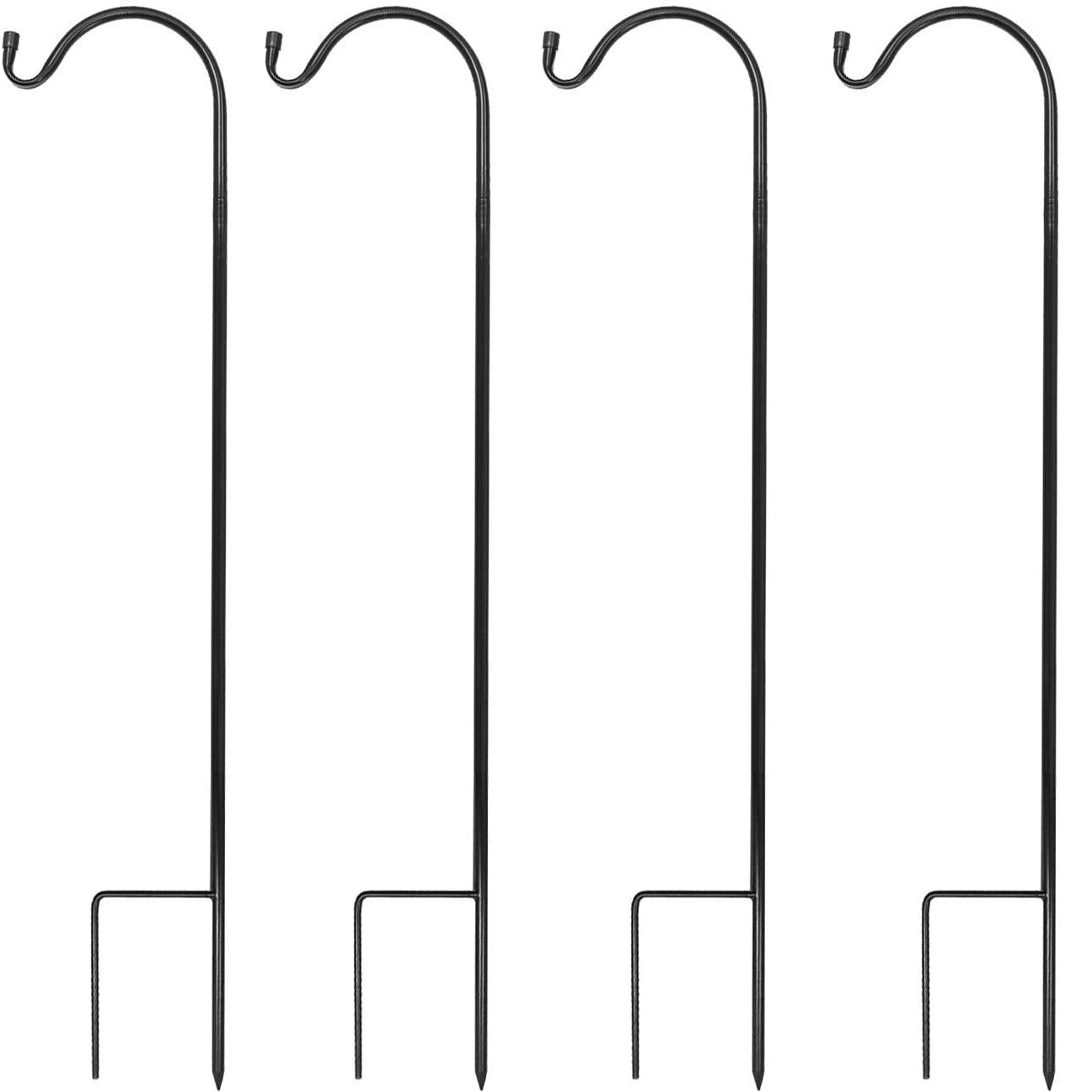
- Item Weight 1.31 pounds
- Sorbus
- 1 x 5 x 35 inches
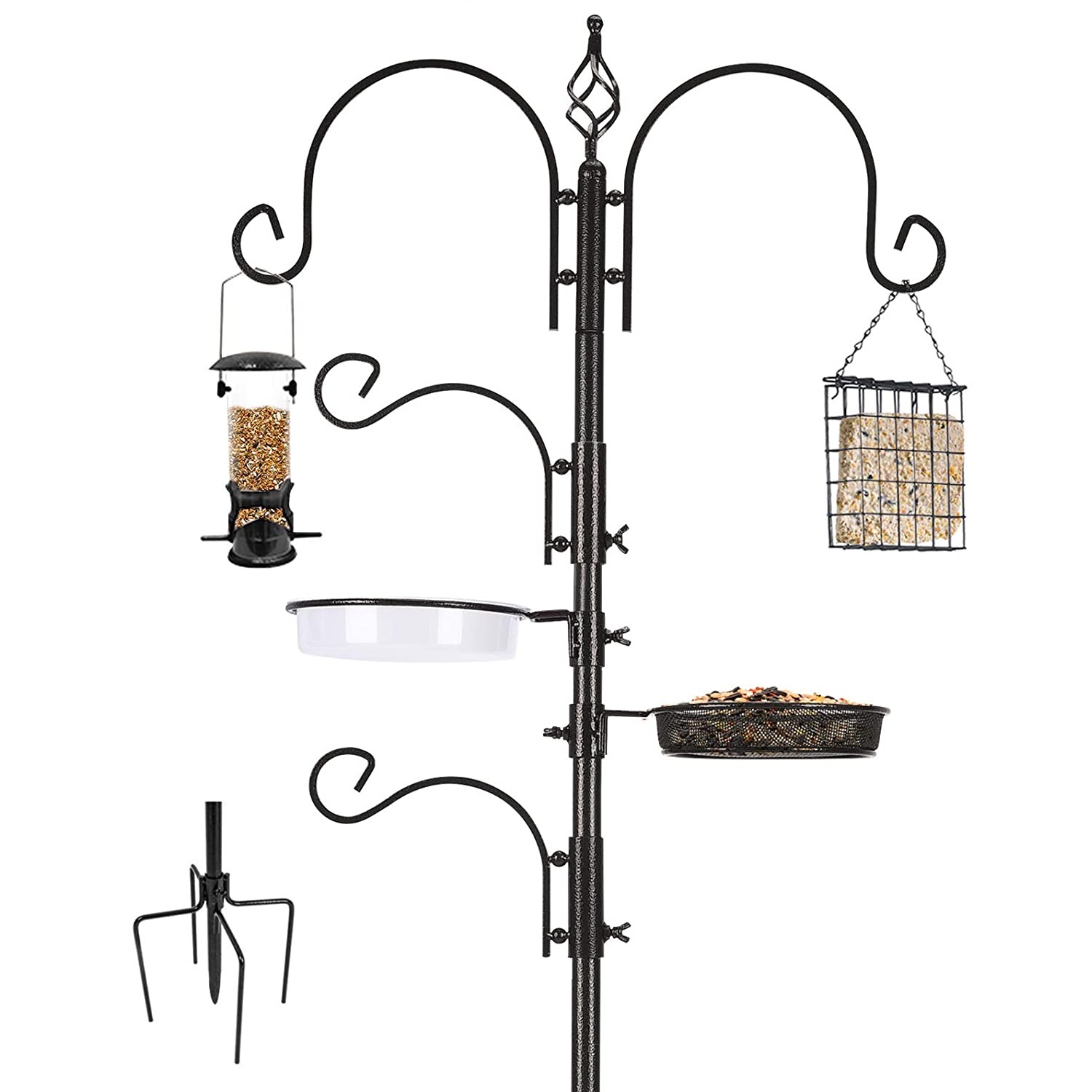
- Brand ERYTLLY
- Color 1 Pack
- Material Steel
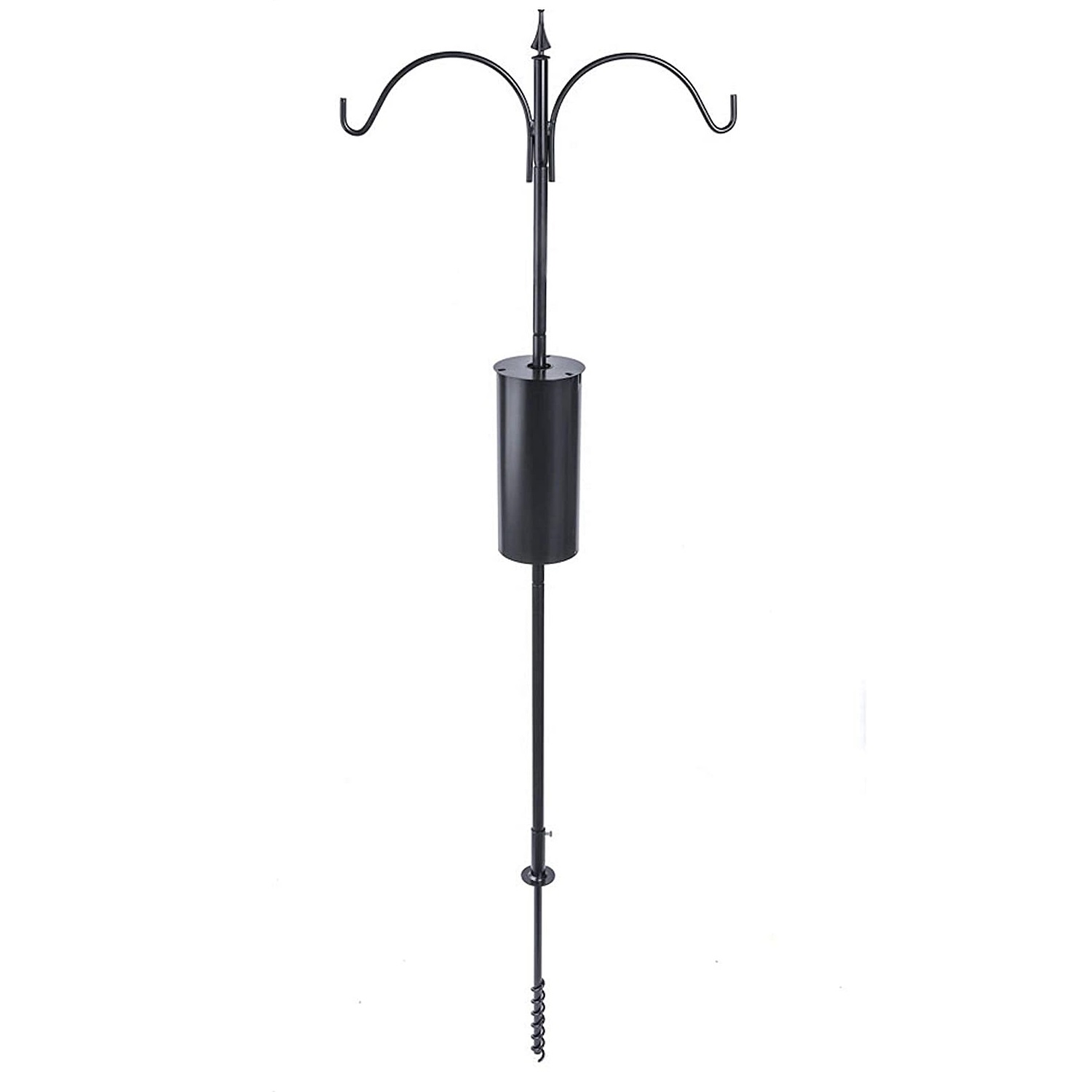
- Brand Birds Choice
- Made of Aluminum
- Material Iron
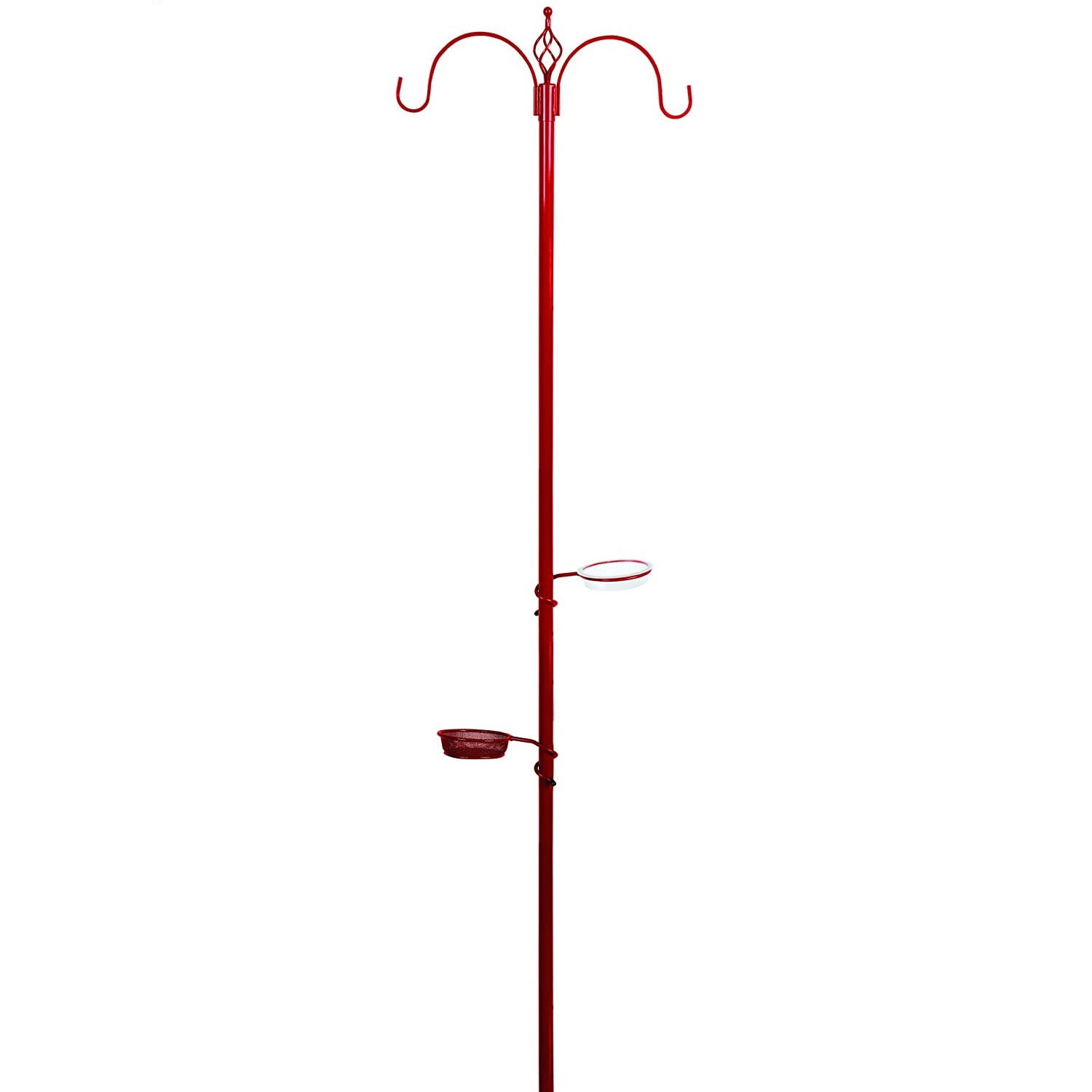
- Brand Gardman
- Color Red
- 1 x 16.34 x 84.65 inches
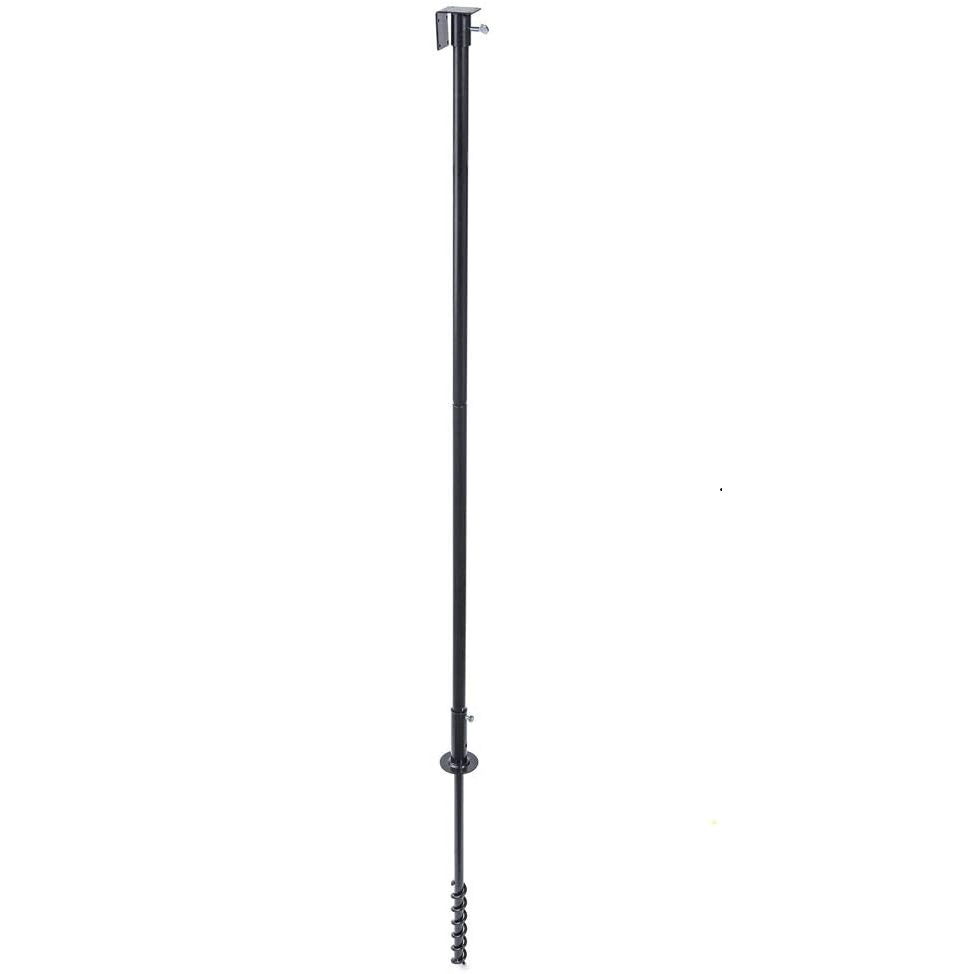
- Birds Choice
- Item Weight 6 pounds
- 4 x 1 x 75 inches
Choose the Best Bird Feeder Pole
Customer’s Choice: the Best Rated Bird Feeder Poles
11 users answered this survey. Please help us improve this review!
The best bird feeder poles can be such a great addition to your backyard. They allow you to watch birds from the comfort of your own home, and they make for some beautiful scenery.
Table of Contents
Benefits of Bird Feeder Poles
The main benefit of a bird feeder pole is that it allows you to place your feeders at different heights. This is especially important if there are multiple people in the household, as everyone can have their favorite height.
A bird feeder pole also helps keep squirrels away from feeding stations by making them jump upwards instead of on top of the stand and then down again. With this system, they don’t get anywhere near the food so will leave hungry – which means less competition for birds trying to eat!
Finally, a bird feeder pole can be an excellent way to deter other animals from coming near your yard. Birds are often scared of heights so they’ll avoid the area and it will discourage raccoons and opossums too.
When you’re looking to buy a bird feeder pole, it can be difficult knowing what’s the best choice for your needs. There are many different types of poles on the market, with all sorts of features and benefits. Here is our comprehensive guide to help you find the best bird feeder poles that will suit your individual needs.
Sorbus Shepherd’s Hooks – the Editor’s choice!
 Get your hands on this set of 4 durable shepherd’s hooks for outdoor décor and more! The height is easily adjustable to fill any space with style. These steel hooks are super strong and will last through all types of weather. With these four attachments, you’ll never have to worry about getting creative again when it comes to hanging up your bird feeders!
Get your hands on this set of 4 durable shepherd’s hooks for outdoor décor and more! The height is easily adjustable to fill any space with style. These steel hooks are super strong and will last through all types of weather. With these four attachments, you’ll never have to worry about getting creative again when it comes to hanging up your bird feeders!
With three different height options, you’ll be able to organize all of your outdoor décor tasks from lanterns to bird feeders, whether it’s a party or just decorating for the season. These elegant hooks are made with durable steel that will last many seasons in any weather – they’re easy to carry too!
Shepherd’s Hooks are a fantastic way to display all sorts of things outside your home. This large set contains 4 bush hooks that can be adjusted depending on height preference. Its simple black finish and steel construction adds style and durability to any outdoor space or event you need! With a weight capacity up to 100 lbs, these hooks will last for many seasons!
Bird Feeding Station Poles Kit – the best for large feeders!
 The Bird Feeding Station Poles Kit comes with everything you need to hang and fill feeders from the top of a tree. Two long, adjustable hooks will be great for hanging those larger hummingbird feeders or the more normal-sized bird feeders that are now in style because of these tough economic times.
The Bird Feeding Station Poles Kit comes with everything you need to hang and fill feeders from the top of a tree. Two long, adjustable hooks will be great for hanging those larger hummingbird feeders or the more normal-sized bird feeders that are now in style because of these tough economic times.
Runners up on avian foods like mealworms are not left out either, as there is an included tray with mesh wire design lined with a plastic bowl for water dishes right next to them. The pole is made from sturdy steel meant to last 22 inches wide and 91 degrees tall – all while easily adjusting where components end up by loosening and tightening nuts depending on your needs (not everyone has trees around their house).
An easy-to-assemble kit for your bird feeding station. The poles are rust-resistant and 91 inches tall, perfect for attracting all sorts of birds while including a wire mesh tray and wire perches for mealworms or fruit.
Birds Choice 2-Arm Topper Pole Set with Squirrel Baffle – the best for easy assembly!
 The Birds Choice 2-Arm Topper Pole Set with Squirrel Baffle is the complete kit for hanging two feeders! The pole set comes with a ground twister to keep squirrels from turning your poles, a black 14 1/2″ cylindrical squirrel baffle, and an easy to assemble 28″ base section. Add sections as high as you need until you get to the perfect height!
The Birds Choice 2-Arm Topper Pole Set with Squirrel Baffle is the complete kit for hanging two feeders! The pole set comes with a ground twister to keep squirrels from turning your poles, a black 14 1/2″ cylindrical squirrel baffle, and an easy to assemble 28″ base section. Add sections as high as you need until you get to the perfect height!
Hang anywhere – in trees or on posts – it’s how happy wings can be when they only fly through air that tastes of hamburger fat instead of mothballs!
This feeder comes with everything you’ll need to hang two feeders – a ground twister, a black 14.5-inch cylindrical squirrel baffle and a heavy-duty pole system that will keep your birdseed safe from pesky little thieves. The 2-arm topper is perfect for hanging large feeders in your garden.
Gardman BA01911 Bird Feeding Station – the best for hummingbirds!
 This colorful, nice-sized bird feeding station will make your backyard a sight to see. The enticing food and fresh water combined with this beautiful view of nature is a must-have accessory for any nature lover.
This colorful, nice-sized bird feeding station will make your backyard a sight to see. The enticing food and fresh water combined with this beautiful view of nature is a must-have accessory for any nature lover.
This feeding station includes an 88.6-inch high feeder set that has extra strength screw together poles and quick fitting accessories, including the birdbath and tray for outdoor use (not intended for the wet environment).
You’ll also find an included bird bath which will look great next to any flowerbed or garden whilst adding some soothing sound as birds fly by after being fed at this feeder station.
Show off your love of nature with this colorful bird feeding station. The extra-strength screw connects poles so it would last longer. And quick fitting accessories like the bird bath ensure you will have a place for your little helper to go when hand-washing is needed (keeping up on those messy little hands).
Birds Choice Bluebird House 54-Inch Pole Set – the best for bluebirds!
 Any gardener, bird watcher, and animal lover will be happy to learn about this product. The Birds Choice Bluebird House 54-inch pole set is just what they need for their backyard accessory collection!
Any gardener, bird watcher, and animal lover will be happy to learn about this product. The Birds Choice Bluebird House 54-inch pole set is just what they need for their backyard accessory collection!
The kit contains 2 pieces of heavy-duty 16-gauge wall and 1-inch diameter black steel tubing. One-ground socket turns 20 inches into the ground and has a set screw and ½-inches turning holes. There’s also a bluebird house flange plate with top or side mounting that includes everything for installation.
The product is a set that you can use for your bird friends or make into something else. The steel parts last forever. You’ll like the house flange plate that makes it easier for any bluebird to make their home and live close to you and nature.
The Buyer’s Guide
Bird Feeder Pole Types
There are many types of bird feeder poles. Bird feeders can be placed on flowerpots, tree branches, or fence posts. There is a wide variety of shapes and sizes to choose from when considering what type you want for your home:
1) Caged poles offer some protection from predators, but this comes at the cost of being more difficult to clean. The metal mesh may also make it hard for smaller birds to reach their food if they do not have access to the cage itself;
2) An uncaged pole means that there will be no barrier between birds and animals looking for a quick meal! This can lead to voracious feeding habits or even injuries as hungry creatures try desperately to get inside your home’s territory. However, many people find that these problems quickly become worth any benefits offered by a caged pole;
3) Telescoping poles have a telescopic pole that can be extended up to 20 feet and collapsed down for storage/transport. They take up little space, but their height is limited by how much extension you want them to go overtime when extended due to wear and tear on the joints with continued use as well as not being able to reach higher areas like trees if placed close enough (the more extension used, the less reliable it gets).
This type also makes it challenging for squirrels and other animals to access your feeders since they need some level of climbing ability which most don’t possess. Telescoping poles are easy to transport and can be adjusted from one length to another. However, because of their telescopic design, they may not provide the stability needed for larger feeders or in high wind conditions.
4) Fixed height bird feeder poles have the advantage of being more stable than telescoping models but this also limits your options when it comes time to change out your feeders. Fixed pole stand heights vary with some stands going as low as 18 inches while others go up to 36 inches. Be sure you know what type of bird seed your future birds will need if deciding on fixed versus telescoping posts.
5) Another type is called an offset perch-mounting pole that has a clamp at the top for attaching your feeder. This style works well with any size feeders (except seed) because you need to adjust how far away from the branch they’re hanging on based on their weight.
6) Another option is the pole with a birdseed tray that you can attach to any tree or post. The problem with this type of feeder is it might not be sturdy enough depending on where you mount it, and also they’re often expensive.
Single Pole vs Pole System
- Single pole
These are only one length and height – generally between 6-12 feet (though this can vary depending on the product). They’re great because they take up little space, but also have a limited range for reaching high areas as well.
These types of poles don’t offer any protection from squirrels or other animals since all you need is climbing ability, so cover your feeders if it’s an issue in your area.
If you’re going with the single-pole option, make sure that it’s tall enough to accommodate bird species (such as cardinals) that need greater heights in order to eat comfortably.
- Dual pole system
This type has two sections that separate at the base and allow them to be placed into different heights based on how long each pole needs to be extended over time due to wear and tear with continued use as well as not being able to reach higher areas like trees if placed close enough.
This type is great because they offer protection from squirrels and other animals due to needing some level of climbing ability which most don’t possess for one pole. However, the trade-off is that it can take up more space depending on the height difference between each section as well as being heavier than a single or telescoping pole even when collapsed down since there are two poles.
Pole systems are usually a much more effective way to feed birds than using just one pole. Pole systems provide two benefits: they offer feeding stations for multiple types of birds and they give your yard additional trees.
Tips for users: if you’re dealing with trees and high areas where your feeders will be placed closer together to prevent easy access by squirrels, then we recommend going with a dual bird feeder pole.
Bird Feeder Pole Materials
Bird feeder poles are available in a variety of materials. Poles are typically made of wood or metal. Some people have even found success with PVC piping, but it’s not recommended for long-term use as the plastic can crack and break over time. Birds will also be attracted to a pole that is stained in some way (e.g. by natural weathering) because this creates an inviting contrast against their dark feathers so they’ll know where to land.
Metal poles may corrode after repeated exposure to rainwater while wooden ones could rot if soaked too often or allowed to become waterlogged; both types must always be maintained periodically with sandpaper, steel wool, linseed oil, paint remover/restorer and other substances depending on what type you’re using. Metal poles should be given a protective coat of paint or another sealant to prevent rusting and last longer. A metal pole would also make an excellent alternative if you want something heavy-duty for larger birds such as grackles or starlings.
Wooden poles are not the best materials for bird feeders because it is difficult to drill holes in them (to attach cups) without tearing through the surface. If you must use one, try drilling only shallowly so that birds can walk across the top instead of perching on its edge. If this doesn’t work well, consider using suet balls rather than cups which will distribute their weight more evenly along with your other favorite treats.
Tips for users: metal is durable but heavy so it needs to be mounted firmly into the ground or other structure, such as your house. Plastic and fiberglass are lightweight and easy to handle but not quite as sturdy. Composite has benefits of both metal and plastic with less weight than either one–but also costs more money for those advantages.
How to choose the best bird feeder pole?
Choosing the right feeder pole is important so that you can set up a feeding station perfect for your birdwatching pleasure. Here are some qualities to look for when finding the best feeder poles for your needs. A few factors to consider:
Durability
A good feeder pole with strong ground support will benefit you in the long term. Low-quality poles can lean or bend easily under the weight of certain feeders and/or without strong ground support.
Easy installation
Some bird watchers go to great lengths in order to get heavy-duty, thick and sturdy feeder poles with a high circumference. However, the diameter of the pole is not what makes it better. Instead of pulling out your post hole digger, choose an easy-to-install feeder pole with detachable ground supports set into it for a quick install.
Accessibility
A bird feeder pole should be both inaccessible and accessible. The pole should be easy for you to reach and difficult for predators like cats to climb. If the feeder is too tall or too short, it might make refilling your birdfeeders difficult or put the birds at risk of becoming a meal.
Squirrel-proof factor
While it is true that birds like to visit when you offer them food and wiggle their tails for fun, other animals also like what you have to offer. Ensure that your feeders are squirrel-proof at the very least so that these types of creatures cannot get to them as easily.
How Tall Should a Bird Feeder Pole Be?
The best height for a bird feeder pole is usually about one to four feet off the ground. When it comes to hanging your new bird feeder, you have a couple of different options: you can hang it from either the bottom or top of the branch – whichever will be easiest for you.
The difference this makes in cleaning out old seeds and debris varies depending on how high up on your tree trunk you place your new feeder. Some people prefer having their seed cleaner at eye level so they don’t need to climb as far. It’s totally worth doing some research before committing to a feeding area that doesn’t work well with your needs and abilities.
Bird Feeder Pole Installation
Install the bird feeder pole according to the manufacturer’s instructions. Be sure you have a solid, sturdy support system in place before hanging any bird feeders from it.
A tree or post is ideal for this purpose. Other options include:
- brackets on your house wall;
- deck railings that are strong enough and not too high off the ground (about waist height);
- metal poles with a threaded screw joint at each end of them;
- brick walls;
Again you need to use a bracket or other mounting device that will not sag under the weight of your feeders. Some poles come with mounting brackets that allow them to attach directly into rock surfaces, trees, posts etc. While other poles require additional hardware such as bolts or nuts and washers in order to install correctly. After installing the bracket on the pole and making sure it is secure, you will need to find the location where there’s a hole in your bracket and insert-type pole.
In general, it is best if the bird feeder pole is at least four feet tall and three inches in diameter. You also want to avoid putting any poles near power lines where they could be electrocuted by electrical surges (birds cannot hear them coming). If there are no trees on your property then attach brackets securely onto your house wall for installation. When attaching brackets to brick walls, drill with caution as they tend to crumble easily!
Also, you may need to do some digging! You want a hole that’s at least one and a half feet deep. That will give your plant enough room to grow without being disturbed by any animals or children who may be nearby. Now set up an anchor system using anchors if needed (if there are boulders), then make sure all of the hardware necessary for setting up the feeder pole is present before continuing with the installation.
Bird Feeder Pole Cleaning
Cleaning a bird feeder pole is not difficult but it does require regular maintenance. Some people may be surprised to learn that the birds themselves are partly responsible for keeping your feeders clean and safe from mold growth or other dirt buildups, by preening. As they eat, birds will often use their bills as grooming tools to comb feathers and pick off any food particles caught in them. They also typically defecate near where they drink which spreads seeds on the ground below the poles of many different types of trees.
But despite the help of birds, it’s still important to occasionally give your feeder poles a good scrub. Try using soap and water for this task as isopropyl alcohol can irritate skin or leave behind an unpleasant odor while ammonia may not be safe around animals and humans because it could cause respiratory irritation and worsen allergies.
To avoid accidentally killing songbirds by soaking them in soapy water, you should always take off all perches before washing them with soap on a bucket below your bird feeder pole.
Fill up the bucket with enough warm or hot (not scalding) tap water to submerge the entire feeder pole. Add one tablespoon of dishwashing liquid to every gallon of the mix until sudsy but not soapy and use a nylon scrub brush to clean the feeder pole. Fill up the bucket again with cool water – soap can cause burns on your bird’s feet so it should be rinsed off before they come back out into contact with you or any other animals in the area.
FAQ
Where to set up the pole?
The first step to installing a bird feeder pole is deciding on the best location for it. A good rule of thumb is that you should place your new bird feeder pole 50 feet from any other trees or signs of human disturbance, such as buildings, sidewalks, and roads. This way birds have enough room to fly in between different areas without getting too close.
The next thing you need to do before installation is making sure there’s plenty of sunlight so the plants can flourish (birds like eating fruits). You’ll need an area with at least 6 hours of direct sunlight daily, which will be important if you plan on planting flowers near the bird feeder pole in order to attract a wider variety of species.
For your feeder pole not to interfere with other feeding stations, you’ll need to place it somewhere out in an open area that has good visibility and no trees or bushes blocking where the birds can see the seed they’ve dropped down onto.
A typical placement would be on one side of your yard near some neighboring houses so as not to exclude your neighbors’ habits if they have them too. If there are areas nearby that might block views or attract animals such as squirrels who will steal the food, your best bet is to bring the pole inside on occasion and put it back out for a day or two when you can.
How do you stabilize a bird feeder pole?
The way you stabilize a bird feeder pole will depend on the type of pole. If it is not too tall, then staking it to the ground or using a tree mount may be enough. However, if your homemade poles are very high and have room for nesting material at their top, they will need to be stabilized with the wires in order to stop them from toppling over under windy conditions.
First, prepare your site by fixing large stakes into the ground so that they point up towards where you want your feeder post to be installed (in this case, pointing upwards). Then tie one end of each wire around a stake before attaching two more wires about halfway down from the top of the post- these should also go around an opposite stake. Next, tie the other end of each wire to a branch or pole that is at least twice as high again- this will stop any sideways movement.
Finally, make sure all anchoring points are firmly fixed into the soil with large anchors so they can withstand strong winds. Once installed securely for windy days ahead, it should be safe enough for birds to climb up and enjoy their food without fear!
Where should you put my bird feeder pole?
A pole should be placed on the ground, and ideally at a height of six feet off the ground when fully extended. This allows for birds to perch comfortably while eating from your feeder. Pole extensions can also add two or three more feet to your reach if desired (but this will make it harder for you to access). When considering where to install your bird feeder, one-third of potential sites are close enough that they don’t require any form of extension, so think creatively!
Tips for users: it is good practice not to place it in the areas with nesting predators such as cats and squirrels. If these animals frequent an area around where you live then consider buying some type of deterrents like a cat collar or pepper spray.
What can you put on a pole to keep squirrels off?
A few products on the market that can keep squirrels off your bird feeders. This includes using a pole with an electric wire at the top to shock them, or by attaching pine cones tied together in different ways and thrown out over trees near the pole where you will hang your feeder from so they’re too high for them to reach.
To prevent other animals like raccoons from hanging around there is also some product called Critter Ridder which is made up of corn cobs soaked in tomcat urine (for attracting cats) mixed into sawdust so it’s all ready to spread around.
Another way of keeping birds fed and squirrels away is to use a pole with bird feeders at the top, and place it near trees where you can also leave corn cobs out for them to eat.
Also, you may try attaching the tied pinecones in different ways and throw them over trees near the pole where they will be hung to make it too high for them.
Can a squirrel climb up a metal pole?
Yes, some squirrels can climb up a metal pole. However, you should buy a feeder that is at least 18″ off the ground to keep them out of range. There are many different types of bird feeders with perches (metal or wood) in various heights on your garden tree. Some have very wide branches and others don’t which will affect how easily they are climbed by squirrels but generally if it’s more than 12″ from the ground then there shouldn’t be an issue for most species unless your squirrel has specialized climbing adaptations such as claws that hook into bark like raccoons do when climbing trees.
Some bird feeders are designed to deter squirrels from climbing them. Some have large, wide perches that make it difficult for a squirrel to get their claws into the wood or metal and move up in an effort to reach food. Other designs feature cages around seed ports that offer protection against pesky animals like raccoons which climb trees better than most other mammals because they have specialized claw adaptations that help grab on to bark. One company even makes thick wire mesh across the top keeping any animal out!
How can you grease a bird feeder pole to keep squirrels off?
There are a few options for greasing bird feeder poles to keep squirrels off:
- Vaseline. Although it’s not as bad for squirrels to climb up this type of pole, the Vaseline will make it difficult for them to get down. That means they’ll be more likely to drop off and end up getting caught in a trap or stuck somewhere else instead;
- Peanut butter. Squirrels are very attracted to peanut butter so you can use that when greasing your bird feeder poles without having to worry about accidentally catching any birds because it is too high up on the pole. You should apply enough that there is at least some on each step and then reapply after rain;
- Bacon fat. This option requires you to cook bacon with oil first before applying it over your bird feeder pole. It is a stronger repellent than Vaseline or peanut butter. It will force squirrels to find another place for their breakfast;
- Lard. As an alternative, you can use lard on your poles as well if the other options are not appealing;
Whatever you choose should be applied with gloves or tongs in order to prevent getting it on your hands then touching the pole as that can make things worse by creating an even larger mess!
Will Vaseline keep squirrels off bird feeders?
If you want to prevent squirrels from being able to climb up your bird feeder pole, put Vaseline on the threads and other parts that will be used by them. This is an effective way of preventing squirrels from climbing on your bird feeders without any harm or discomfort for the animals.
However, Vaseline will not repel all squirrels off bird feeders. Vaseline is an animal product that might be attractive to some squirrels because it has the same consistency as tree bark and smells similar as well. Squirrels are adept at finding ways around barriers like this or just opening up anything using their teeth if they want food badly enough.
Vaseline is an option that many homeowners have tried with mixed results: sometimes it works, but other times it doesn’t work as well on certain squirrel species. If you live in a region that has grey squirrels, Vaseline could be your best bet. If you live in a region with red squirrels, Vaseline is not advised.
Do coffee grounds keep squirrels away?
Coffee grounds do not repel squirrels, but they can make a mess and stain your feeder. If you want to keep the critters away without harming them with chemicals or trapping methods, try planting some of the plants that are poisonous to squirrels: saffron crocus bulbs (bottom), castor beans (middle) and foxglove flowers (top). These will help deter hungry invaders from getting too close.
If you do want to deter squirrels with coffee grounds, mix them in a jar and spread the mixture on your ground or around other areas of your yard that are frequented by squirrels. This will not only keep them out but also help fertilize your garden!
How far from the house should the bird feeder be?
The rule of thumb is at least 25 feet from the house, but it should also be a minimum distance away from bird-feeder poles. It’s important to give birds plenty of room to fly around and eat their food in peace.
Some people believe that the closer it is to their house, the more birds they will attract because there are likely to be fewer trees and bushes between them. Others suggest leaving it at least 30 feet away so you can enjoy watching all sorts of different species come in for food.
Regardless, if you live near an open lawn with few plants around your house then any distance may work well as long as you provide plenty of choice by installing several types from our list. If instead, you live in a heavily forested area or near water where there’s lots of greenery blocking views, place your feeder high up in a tree or an area with more visibility.
What are the most popular bird feeder pole brands?
Bird feeder poles come from a variety of brands, but some are more popular than others are. There’s no right or wrong answer to this question – it all comes down to personal preference. Popular pole brands include Perky-Pet and InSinkErator because their products have been around for many years and they’re well known in the bird feed industry (and elsewhere). However, they are quite expensive. Some consumers also think that these companies offer high-quality items at affordable prices. Other popular manufacturers include Sorbus, Bird Feeding Station, Birds Choice, etc.
Useful Video: Best Squirrel Proof Bird Feeder Pole and Baffle System
Final thoughts
Finding the best bird feeder pole is a process that requires patience and research, but, hopefully, this comprehensive guide has helped you get started. Remember to keep your needs in mind when shopping for a new bird feeder pole! If you have any thoughts or questions about the expert recommendations, please don’t hesitate to reach out.

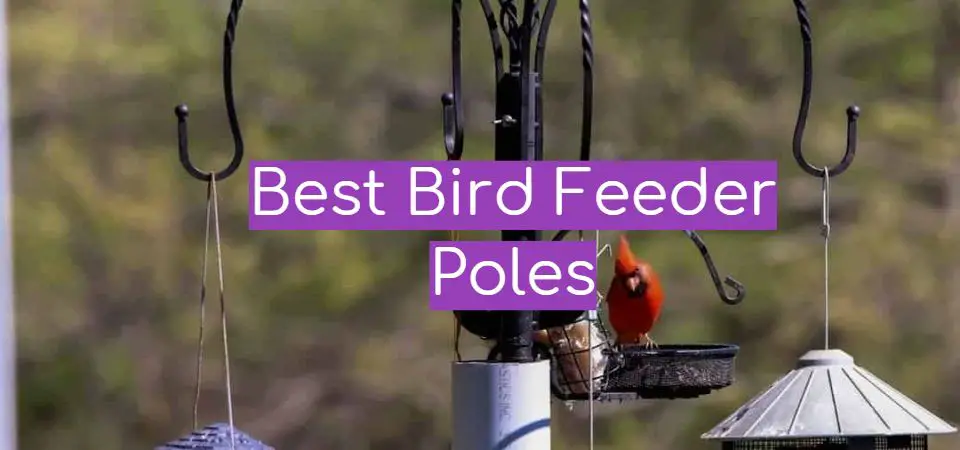
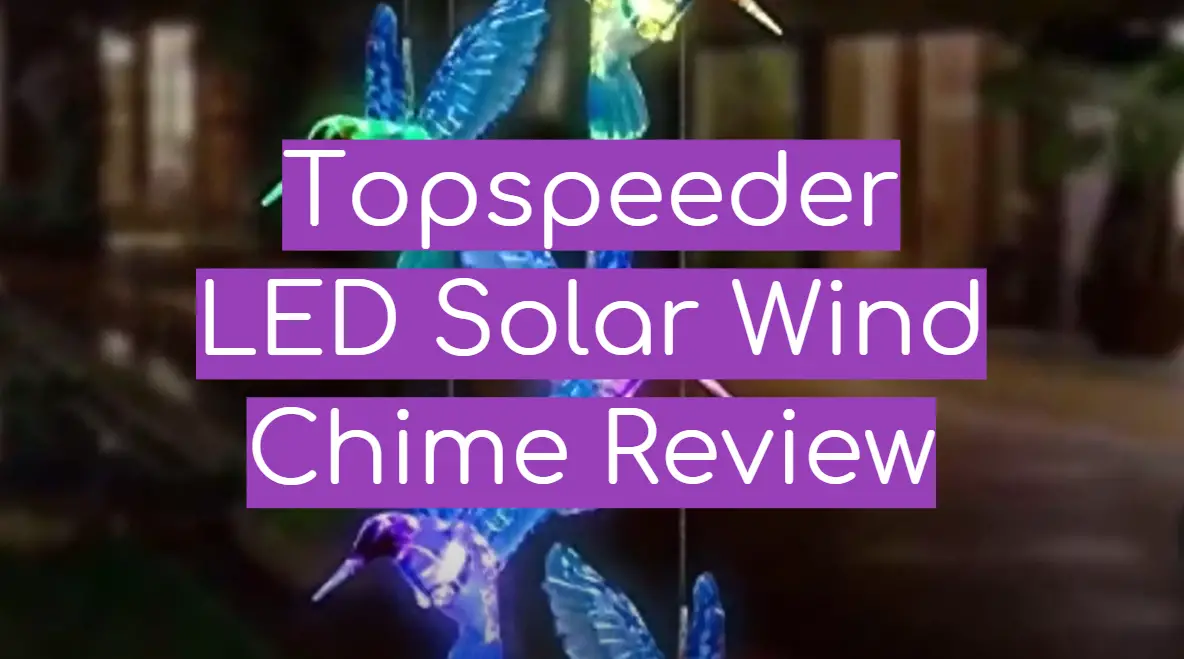
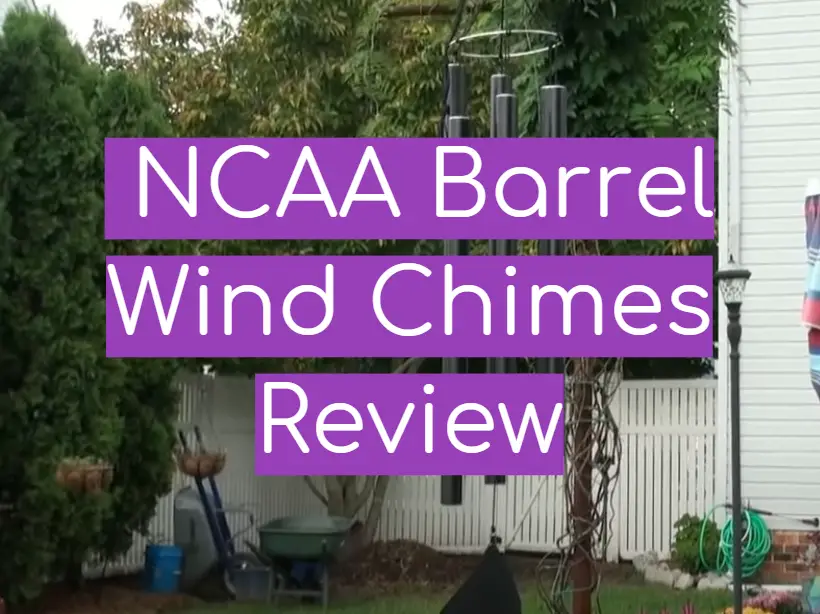
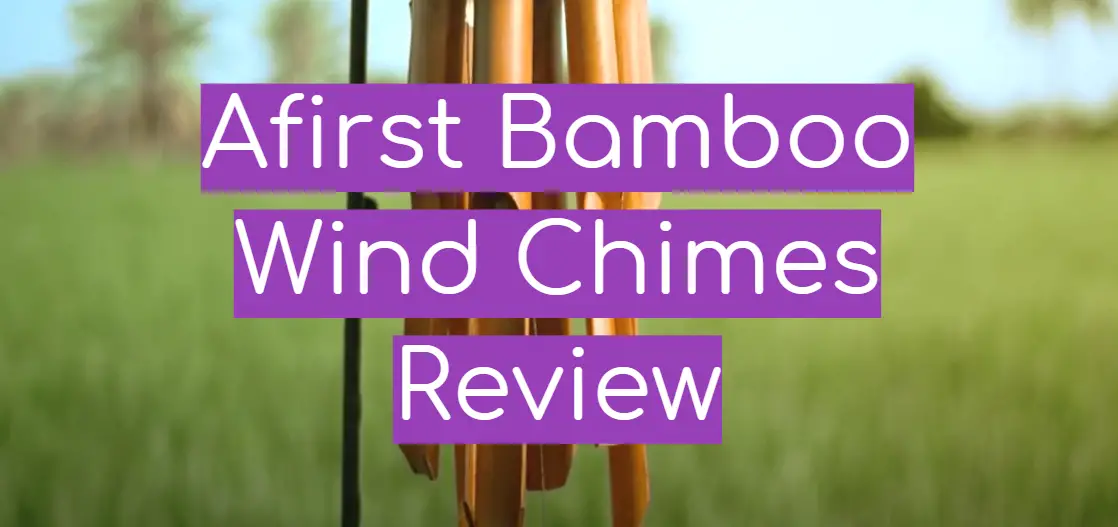
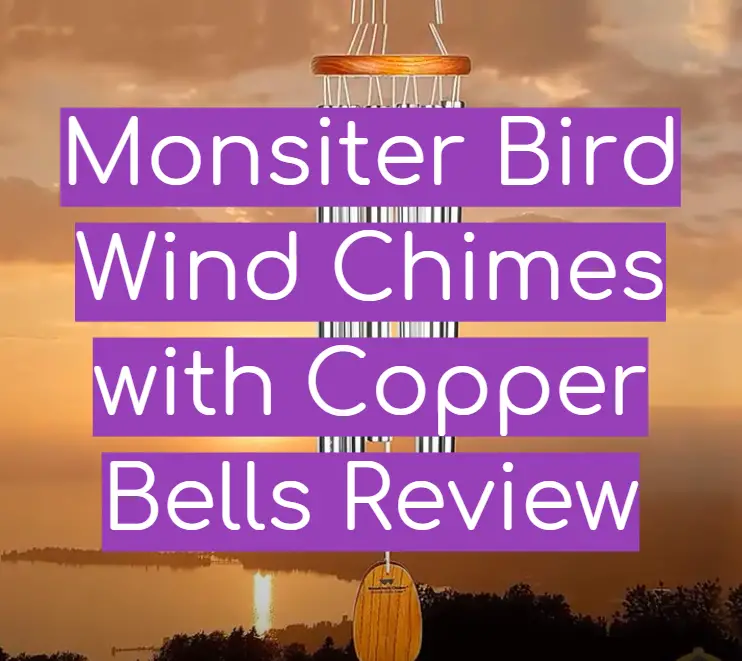
Leave a Reply